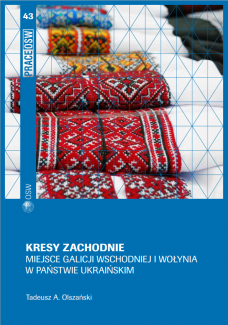Summary: The Western Borderlands. The place of Eastern Galicia and Volhynia in the Ukrainian state

Key points:
- The regions of Ukraine are strongly diversified. These differences are subject to historical conditions and attempts at unification which have been made over the past seventy years have proven that these differences will be impossible to reduce in the foreseeable future and will continue to bear an impact on Ukraine’s domestic policy.
- Western Ukraine (Eastern Galicia and Volhynia) is a peripheral region in economic, political and cultural terms. Although it accounts for approximately 14% of Ukraine’s territory and 15% of the country’s population live there, the region generates only around 10% of the country’s GDP. Its metropolis, Lviv, Ukraine’s seventh largest city, was traditionally among the key centres in the nation’s history. However, its role in an independent Ukraine has been marginalised partly due to the fact that a significant part of its elite moved to Kyiv. This is also the most ethnically homogeneous region, where Russian speakers make up rather a small part of the population.
- There is a vast historic difference between Volhynia and Eastern Galicia. Volhynia has close ties with central Ukraine and has been bound to it throughout most of its history. In turn, Eastern Galicia (Red Ruthenia, Halychyna) throughout a greater part of its history was not politically or economically linked to Dnieper Ukraine. It had stronger bonds with Poland and Hungary. However, it was Eastern Galicia that became the cradle of modern Ukrainian national thought.
- In the aftermath of World War II, the lands which are now Western Ukraine were annexed to the Ukrainian SSR, and the region underwent deep demographic changes (the extermination of Jews, the extermination and then displacement of Poles, mass deportations of the Ukrainian elite followed by a mass influx of Ukrainians from the east and Russians). The Soviet government embarked on an industrialisation policy which, however, failed to cope with the underdevelopment of the region. The fact that numerous Soviet Army troops were stationed here was a major economic, political and social factor in this region.
- When Ukraine regained independence, its western part plunged into a deep economic and social decline. However, the consequences of the industrial and agricultural collapse were alleviated by new opportunities for cross-border trade, work linked to the border, and employment abroad. The economy here has been recovering at a much slower rate than in the rest of the country (with the exception of Volhynia Oblast, being one of Ukraine’s most rapidly developing districts), but its foundations are healthier since it relies to a great extent on small and medium-sized businesses.
- Western Ukraine predominantly supports national-democratic and nationalist political groupings, and demonstrates reluctance towards the culture of the eastern part of the country, Russia and Russians, as well as – albeit to a significantly smaller extent – Poland and Poles. (This is more the case with the Galician than Volhynian oblasts).
- Western Ukraine does not have its own politico-economic ‘clan’ with nationwide impact, and regional politicians have no ambition to actively influence Kyiv’s policy. However, local oligarchic systems, which are based on controlling agriculture, food industry, marketplace trade, railway transport, and also restaurants, hotels, etc., are not absent here. The expansion of entrepreneurs from eastern Ukraine, and – in politics – the growing influence of the Party of Regions have been seen in the western districts for the past decade or so. On the one hand, this contributes to economic growth. On the other – at least in Eastern Galicia – this causes tension in political relations and foments nationalist sentiments.
- Eastern Galicia is the pivotal place for the Ukrainian nationalist movement, in both its democratic and radical forms, which draws upon the tradition of the Organisation of Ukrainian Nationalists (OUN) and the Ukrainian Insurgent Army (UPA). Traditional post-OUN organisations are weakening, while the Svoboda party is developing rapidly. Svoboda is a modern party in intellectual and organisational terms, it represents radically nationalist views, and it is not without reason that it is seen as being inclined towards fascist ideology. Nothing seems to signify a decline in the numerous, intergenerational nationalist electorate in the Galician districts of Ukraine.
- Until World War II, Greek Catholicism predominated in Eastern Galicia and Orthodoxy in Volhynia. The Greek Catholic Church, which was banned by the Communist regime, survived the persecutions. However, it has been unable to regain its previous significance after 1991 – at present approximately one third of religious people in Galician districts are members of the Orthodox Church. Western Ukraine has a significantly higher share of practising religious people than the rest of the country (approximately 52% in Volhynia and 70% in Galicia, whereas the national average is 24%).
- The Ukrainian Greek Catholic Church (the official name) operates mainly in Eastern Galicia and among emigrants from this region. Ukrainian Orthodoxy is divided: the main structure, the Ukrainian Orthodox Church, predominates in Volhynia; the Ukrainian Orthodox Church – Kyiv Patriarchate is the church chosen by most Orthodox Christians in Galicia, and it also has significant influence in Volhynia; and the Ukrainian Autocephalous Orthodox Church (the least numerous) operates mainly in Eastern Galicia. There is hardly any chance for a unification of Ukrainian Orthodoxy.
- Roman Catholicism is the religion of Poles and people of Polish background. The number of members of this church in Western Ukraine ranges between 45,000 and 160,000. The attitude of local governments to this church is one of reluctance, to say the least (better in Volhynia than Galicia). More and more Catholic priests are citizens of Ukraine, and the use of the Ukrainian language in liturgy is increasingly widespread (Russian is also used in other regions of Ukraine).
- According to data collected during the census in 2001, the Polish minority in Western Ukraine is approximately 40,000. Beyond any doubt, their number is underestimated. Nevertheless, the Polish population in Ukraine is decreasing as a consequence of both assimilation and emigration. The Polish population is dispersed. Although they are quite well-organised, they still rely in their activity on assistance from Poland. Polish organisations are divided and do not always coordinate their efforts. Local governments are usually indifferent to their needs. One exception is Lviv, where the city government’s hostility towards the aspirations of the local Polish community is strongly entrenched.
- The Russian population in Western Ukraine is approximately 180,000 (one third of them live in Lviv). A part of the younger generation is undergoing Ukrainisation. Local Russians show no political ambitions. Other minorities are small (the most numerous being Belarusians at 15,000) and do not play any role in the region’s public life.
- Lviv, the regional metropolis with an official population of approximately 750,000 (and an unofficial population of around one million) and, despite deepening marginalisation, is still an important intellectual centre. The enormous disillusionment of its elite with independence and the fear of the linguistic and ideological Russification of the Ukrainian state strengthens autonomist and even separatist ideas in this city. These ideas are at present marginal, but beyond any doubt there is fertile ground for them to develop in. One of the prerequisites for such development is the excessive centralisation of the Ukrainian state, which does not allow the deep regional differences to be used for the benefit of the state.
- An important element of the identity of Western Ukrainian residents (to a greater extent in Galicia and to a lesser in Volhynia) is their attitude to Poland and, more precisely, their resentment linked to the memory of Polish rule in these territories. This resentment was at first encouraged by Communist propaganda, and later by nationalist propaganda. The anti-Polish sentiments are gradually waning, but the young generation is not free of them, either. In addition to the historical stereotype, a new one is emerging – that of a Pole as an employer or public servant from today’s Poland, based on the experience of Ukrainians working in Poland.
- The Soviet manipulation affected the historical memory of the Ukrainians from the west. The main response to this manipulation was a ‘repainting’ of mind patterns from ‘class-based’ into ‘national’. As a result, a martyrological-triumphalistic vision of history developed in Western Ukraine. In a narrative of this kind, there is no place for crimes committed by Ukrainian nationalist formations, especially UPA, and in this vision Ukraine is presented (exactly as with the Soviet Union earlier) as a country surrounded by enemies. Thus reflection on the nation’s history and identity is being restrained.





